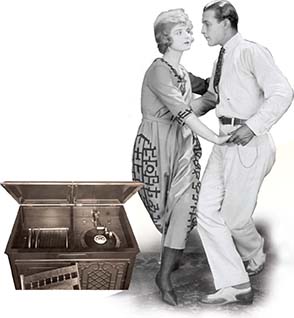SECTION 4: A New Mass Culture

◄ Couple dancing to phonograph music
WITNESS HISTORY  AUDIO
AUDIO
“Ain’t We Got Fun?”
The phonograph had come a long way from that day in 1877 when inventor Thomas Edison had recorded himself reciting “Mary Had a Little Lamb.” By the 1920s, Americans were buying thousands of phonographs and millions of shiny phonograph records. In the comfort of their living rooms, they listened and danced to popular songs that reflected the carefree spirit of the age. One hit tune of 1921 told of a young couple who were determined to enjoy themselves even though they didn’t have much money:
“Night or daytime, it’s all playtime,
Ain’t we got fun?
Hot or cold days, any old days,
Ain’t we got fun?
If wifie wishes to go to a play,
Don’t wash the dishes, just throw them away!”
—Gus Kahn and Raymond B. Egan, “Ain’t We Got Fun?”
Objectives
- Trace the reasons that leisure time increased during the 1920s.
- Analyze how the development of popular culture united Americans and created new activities and heroes.
- Discuss the advancements of women in the 1920s.
- Analyze the concept of modernism and its impact on writers and painters in the 1920s.
Terms and People
- Charlie Chaplin
- The Jazz Singer
- Babe Ruth
- Charles Lindbergh
- flapper
- Sigmund Freud
- “Lost Generation”
- F. Scott Fitzgerald
- Ernest Hemingway
NoteTaking
Reading Skill: Summarize Look for ways in which culture changed during the 1920s.
Why It Matters The automobile reshaped American culture, creating new forms of recreation and making it easier for people to travel. Other factors also contributed to changing ways of daily life. Americans listened to the radio, went to the movies, and followed the exploits of sports heroes. In the process, a new mass culture emerged—one whose shape and character closely resemble our own. Section Focus Question: How did the new mass culture reflect technological and social changes?
New Trends in Popular Culture
The 1920s was in many respects the first decade of our modern era. Even as cultural issues divided Americans from different regions or economic levels, technology was beginning to break down other barriers. Nowhere is this more evident than in the leisure interests of the American people.
Americans Enjoy More Leisure Time
The growth of cities changed leisure patterns. On farms, people worked from dawn to dusk, with little time to spare. In the evenings, a farm family might play games, read, or sing together around the piano. Occasionally, they joined other farm families and townsfolk for picnics or a game of baseball. They did not have the time or the money for more extensive leisure pursuits.
City life was different. The average workweek in all industries fell from 70 hours in 1850 to 55 in 1910 to 45 by 1930. The workweek itself also changed from seven days a week to six and at last to five. At the same time, salaries and wages were on the rise.





